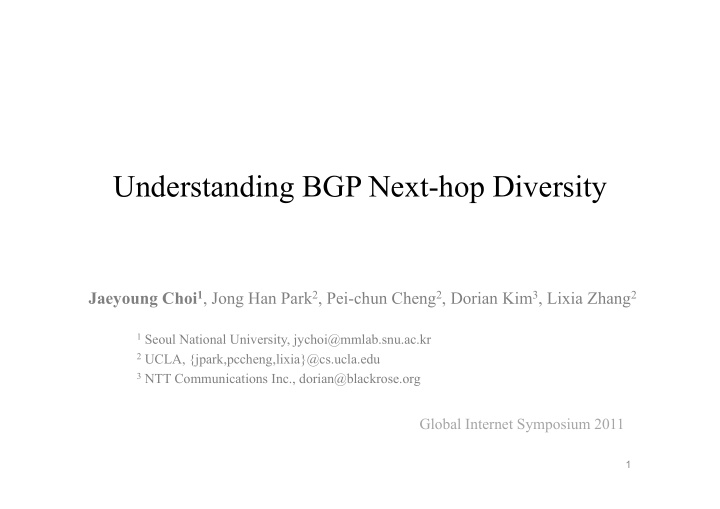



Understanding BGP Next-hop Diversity Jaeyoung Choi 1 , Jong Han Park 2 , Pei-chun Cheng 2 , Dorian Kim 3 , Lixia Zhang 2 1 Seoul National University, jychoi@mmlab.snu.ac.kr 2 UCLA, {jpark,pccheng,lixia}@cs.ucla.edu 3 NTT Communications Inc., dorian@blackrose.org Global Internet Symposium 2011 1
Why this work • High path diversity is important – Increase network robustness for failures – Increase flexibility in traffic engineering and load balancing – Decrease convergence time when topology changes • IETF efforts to increase path diversity – WG Diverse-path, Add-Path, Best-External – Proposes several ways to modify BGP to support multiple paths • What is the existing path diversity in the operation networks? How does it change over time? – Are the modifications necessary? – What is the effective way to modify BGP to support multiple paths? 2 / 16
High level description of measurement ISP • ISP A (Tier-1 ISP in the Internet) using AS confederations – Backbone sub-AS with more than one hundred i-BGP routers in a full-mesh • Spreads across 14 countries and 3 continents Most prefixes are announced directly to one of the routers in the backbone sub-AS • • A collector is placed in the backbone sub-AS to passively collect i-BGP data 3 / 16
Quantifying next-hop diversity • Why next-hop diversity? – ISP’s concern on path diversity is confined to next-hop diversity within their network s • Dataset – Routing table snapshots during one month of July 2009 – Filter out internal prefixes and potential bogon prefixes • Filter out prefixes with their length smaller than 8 or greater than 24 4 / 16
Defining next-hop diversity • Next-hop {AS,POP,router} diversity – The number of unique next-hop routers along with their geographical locations (i.e. city) and next-hop ASes for a prefix ISP_A ISP_A ISP_A AS AS AS AS AS AS AS Origin Origin Origin • Next-hop router Div.: 3 • Next-hop router Div.: 4 • Next-hop router Div.: 3 • Next-hop AS diversity: 1 • Next-hop AS diversity : 3 • Next-hop AS diversity : 3, not 4 5 / 16
Existing next-hop diversity of ISP A • Based on RIB on July 1 st 2009 (276,712 prefixes in total) – Majority of prefixes (more than 11% and 18%) can be reached via more than 2 next-hop r outers and POPs – More than 60% of prefixes can be reach via only one next-hop AS – A small number of prefixes have a very high degree of next-hop router 6 / 16
Neighbor AS type and diversity • 4 types of AS: (1) stub, (2) small ISP, (3) large ISP, and (4) Tier-1 • In general, ISPs with larger size tend to have more peering sessions across different routers and POPs – ISP A and other Tier1s have 6 to 12 next-hop routers – ISP A and large ISPs have 1 to 12 next-hop routers • Stub AS with high connectivity (ex: UltraDNS, Amazon, Akamai) 7 / 16
Is our observation representative? • Additional measurements performed on RIBS from 4 different dates – The number of next-hop routers are very similar across all measurements – Additional analysis on other results confirm our previous observation 8 / 16
What are the impacting factors of next-hop diversity? • Impacting factor analysis through case studies • Major factors impacting next-hop diversity in ISP A – ISP’s path preference (policy) – Number of peering routers with its neighbor ASes – Lack of geographical presence 9 / 16
Low diversity • Two explanations – (1) Only one path exists – (2) BGP selects and propagate only the best path and hides the rest • Our further investigation confirms the latter – For most of prefixes, multiple paths do exist based on Cyclops ( http://cyclops.cs.ucla.edu/) – Network operator may be able to increase their diversity by adjusti ng tunable parameters of BGP (ex: weight, local-pref) 10 / 16
Moderate diversity • Prefixes whose next-hop router diversity is between 6 and 12 – Applies to more than half of all prefixes – Prefixes are reached through an AS that maintains multiple BGP peering sessions with ISP A • This case shows us that – # of peering routers has an impact on the next-hop diversity Case 1 Case 2 11 / 16
High diversity • Interesting characteristics – Many equal-length AS_PATHs – Length of AS_PATH to reach ISP A is always > 1 • Lack of geographical presence of ISP A – For 89% of prefixes with high diversity, ISP A do not have a presence at the prefix origination POP – Some prefixes can have a very high diversity regardless of the ISP’s intention 12 / 16
Does diversity change in time? • What is a general trend of next-hop diversity changes over time? • Dataset – Sampled the routing table snapshot taken on 1 st day of each month from July 20 07 to July 2009 – Only consider common prefixes that exist in all RIBS • 220,432 prefixes in total 13 / 16
Next-hop diversity changes over 2 years • Median values stay almost the same – The diversity of individual prefixes change in unpredictable manner, compensating the changes of other prefixes – As a result, no noticeable aggregate change in time • 95 th , 99 th , Maximum values slightly increase – Number of backbone routers inside ISP_A have increased up to 19 additional routers during the 2 years 14 / 16
Summary • Despite the promising efforts to increase path diversity, little understanding on path diversity in the existing system • Our quantification and analysis on Tier-1 iBGP routing data show – Majority of prefixes can be reached through multiple next-hop routers – Some of the high diversity is unintended – ISP may be able to increase their diversity without any BGP modifications by a djusting path preference and number of peering routers – Overall diversity has not changed a lot in time 15 / 16
Any questions? Thank you. 16 / 16
Recommend
More recommend